Lecture 20 Shortest Paths: The Last Lab Decimal vs. Fraction
advertisement
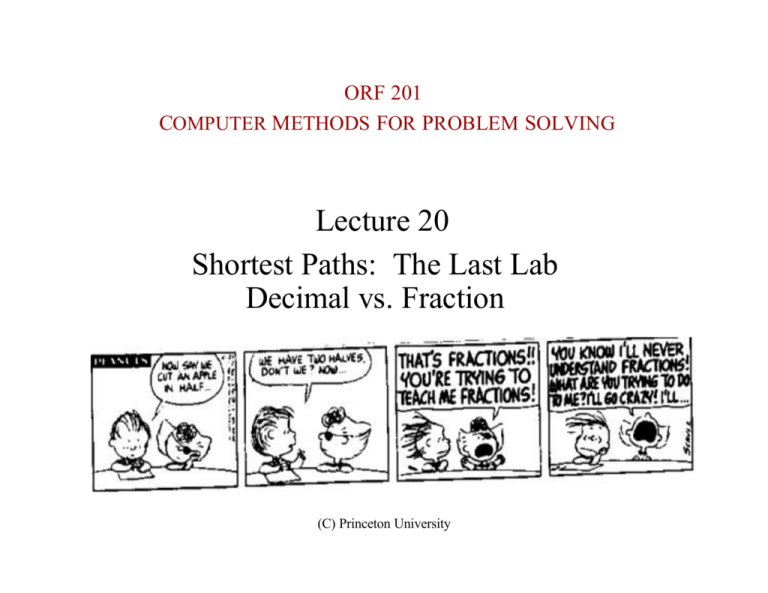
ORF 201
COMPUTER METHODS FOR PROBLEM SOLVING
Lecture 20
Shortest Paths: The Last Lab
Decimal vs. Fraction
(C) Princeton University
Shortest Paths Problem
Given:
• Network: (? ,? )
• Costs = Travel times: cij, (i, j) ? A
• Home (root): r ? N
Problem: Find shortest path from every node in N to root.
2
Dijkstra’s Algorithm
Notation:
• Put vi = min time from i to r
- Called label in networks literature.
- Called value in dynamic programming literature.
• F = set of finished nodes (labels are set).
• hi, i ? N = next node to visit after i (heading).
Dijkstra’s Algorithm:
• Initialize:
F??
?0
v??
??
j
j?r
j?r
• Iterate:
- Select unfinished node with smallest vk. Call it j.
- Add j to set of finished nodes F.
- For each unfinished node i having an arc connecting it to j:
- If cij + vj < vi, then set
vi = cij + vj
hi = j
• Stop: when no unfinished nodes remain
3
Dijkstra’s Algorithm - Complexity
• Each iteration finishes one node: m iterations
• Work per iteration:
- Selecting an unfinished node:
- Naively, m comparisons.
- Using appropriate data structures, a heap, log m comparisons.
- Update adjacent arcs
• Overall: m log m + n
4
Fractions
Two choices:
Create a Fraction class
consisting of two integers, num
and den, and write all code using
Fraction instead of double.
Fraction
Write all code using double
to represent numbers. Convert
from/to fraction format on
input/output.
Advantages:
• Seems safer - one implements
exactly what one expects:
greatest common denominator,
reduction to simplest form, etc.
double
• Simple to program.
• Very little danger of overflow.
• Easy to switch between decimal
and fraction format.
Disadvantages:
• Integer overflow during temporary
computation is a danger.
• Code is hard to read:
e.g. z = x.add(y) to add
Fraction x and y and store in z.
• Could make small mistakes.
5
Converting Reals to Fractions
Two methods:
• Brute Force: Start with den = 1 and try each possible den until
the associated num is an integer (with a small tolerance). This works
but is terribly inefficient.
• Continued Fractions: Represent a real number x by its continued
fraction expansion:
1
x ? b0 ?
1
b1 ?
1
b2 ?
b3 ? ...
Truncate after a finite number of terms. This method is amazingly efficient.
Computing the bj’s:
• Put t0 = x
• Put bj = greatest_integer(tj)
• Put tj+1 = 1/(tj - bj).
• Repeat.
6
Rationalizing Continued Fractions
How many terms? Unlike series expansions, you can’t just evaluate a continued
fraction from left to right stopping when the change gets small.
The obvious way to compute starts with a blind guess of how many terms to use,
then starts at the right and works back up to the left.
But there is a beautiful way to compute from left to right.
Let:
Aj
Bj
? b0 ?
1
b1 ?
1
b2 ? ... ?
Initialize:
A? 1 ? 1
A1 ? b0
B? 1 ? 0
B1 ? 1
1
bj
Compute each ratio successively:
Proof by induction:
First check j = 1:
A j ? b j ?1 A j ? 1 ? A j ? 2
B j ? b j ?1 B j ? 1 ? B j ? 2
A1
1 b b ? 1 b1 A0 ? A? 1
? b0 ? ? 1 0
?
b1
B1
b1
b1 B0 ? B? 1
Now assume true for all 1,2,…, j - 1 and check it for j
7
Method contFrac in class Format
static public String contFrac(int width, int precision, double t)
{
int bj=0, Aj=0, Aj1, Aj2, Bj=1, Bj1, Bj2, num, den;
boolean pos;
double tj, maxDen = Math.pow(10, precision);
String numstr0, numstr;
if (t >= 0) { pos = true; tj = t; }
else
{ pos = false; tj = -t; }
bj = (int) (tj+1.0e-12);
tj = 1/(tj-bj);
Aj = bj; Aj1 = 1;
Bj = 1; Bj1 = 0;
num = Aj;
den = Bj;
if (!pos) {num = -num;}
numstr0 = "";
numstr = fracString(num, den, width, precision);
while (Math.abs(t - Aj/(double)Bj) > 1.0e-12
&& numstr.length() < width && Bj < maxDen ) {
Aj2 = Aj1; Aj1 = Aj;
Bj2 = Bj1; Bj1 = Bj;
bj = (int) (tj+1.0e-12);
tj = 1/(tj-bj);
Aj = bj*Aj1 + Aj2;
Bj = bj*Bj1 + Bj2;
num = Aj;
den = Bj;
if (!pos) {num = -num;}
numstr0 = numstr;
numstr = fracString(num, den, width, precision);
}
8
return numstr0;
}
A Test Program
/***********************************************************
* Program to compute rational approximations to PI
**********************************************************/
import myutil.*;
public class ContFrac
{
public static void main(String[] args)
{
double x = Math.PI;
/****************************************************
* using static formatting methods
*/
System.out.println();
System.out.println("Using static formatting methods");
System.out.println();
System.out.prinln("pi = "+Format.floating(10,5,x));
for (int j=0; j<10; j++) {
System.out.println("pi = "+Format.contFrac(2*j+1,j,x));
}
}
}
9



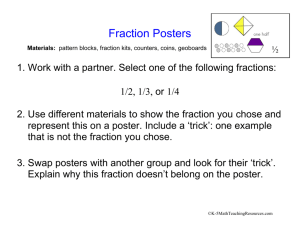



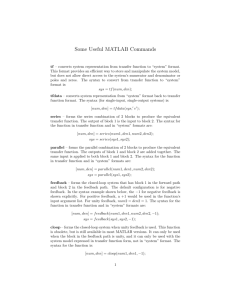
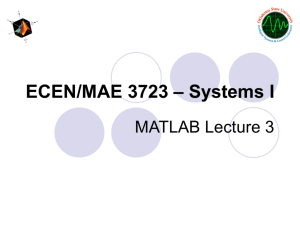
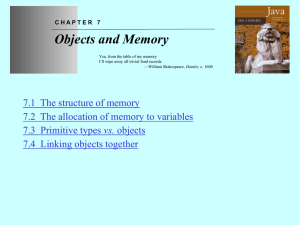
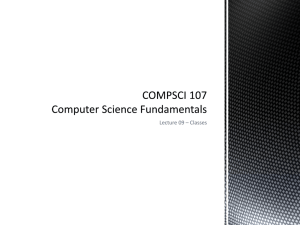

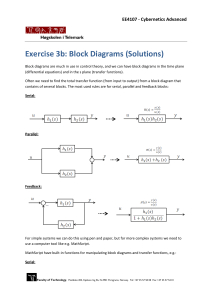
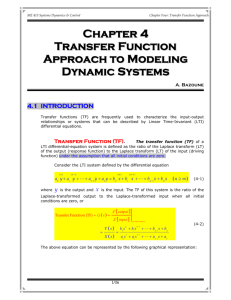
![The Delta Sequence - - - δ [n] The Unit-step Sequence - -](http://s3.studylib.net/store/data/008271070_1-8352eb9dabbf35bf5124ba6d80c4359f-300x300.png)